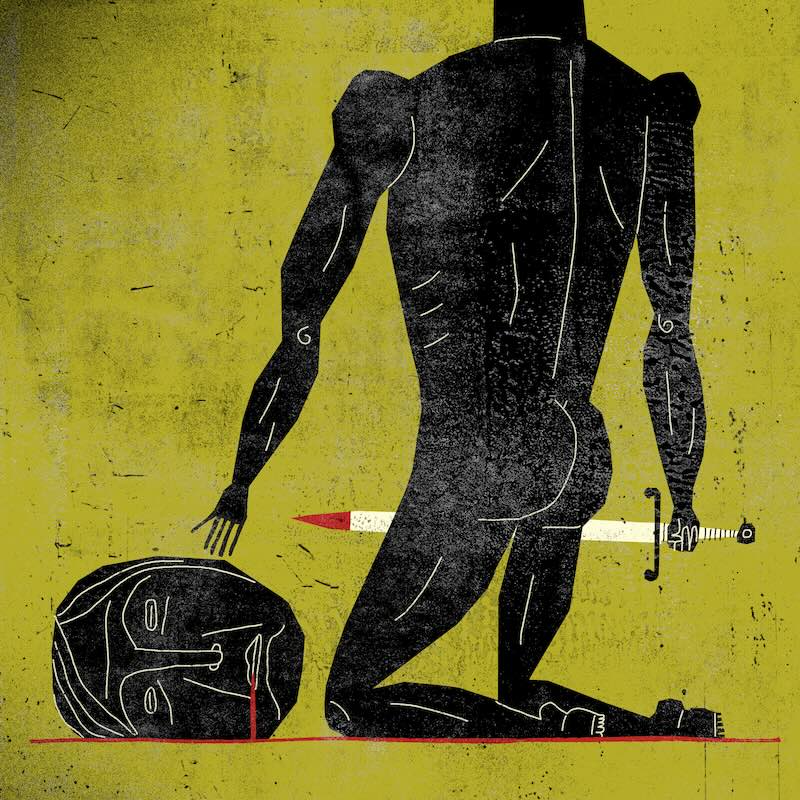Uprooted: On my dance background
I gave up on hardcore classical ballet midway through elementary school because I didn’t want to leave my house on Saturday mornings anymore. When I got to middle school, I would get up at 6 a.m. on Saturdays to get to 7 a.m. synchronized skating practice. (It might have been even earlier.) Little mover Daniella…had her priorities in order. Something about the pressure, gliding, and fluid motions of skating made me feel freer. There was also the fact that I saw more Asians at the rink in the early 2000s and 2010s.

These days, I don’t really dance…or skate. I’ll move when a show calls for it and primarily dance for musical theater. I skate once every winter on outdoor DC ice rinks and show off at public sessions. I have better tools to express myself through movement after taking classes in college, especially in a dance improvisation class that expanded my sense for identifying and analyzing movement. So I can still flow. But I can’t jerk; the minutiae of isolations and fast-paced phrases can scare me. I’m an artist who works through words and music — and my body is still working to wake up, fully commit, and help me out as I try to perform again.
I wonder if I’ve forgotten where I came from. I wonder if the instincts in my body from my childhood still somehow serve me, somewhere deep down. I wonder if I think more about fight or flight than about allowing myself to feel free, and I wonder if the lack of strong movement in my life has hindered me.
Walking into Dana Tai Soon Burgess Dance Company’s An Asian American Dance Journey concert at Woolly Mammoth Theatre — the first in a new partnership between the longtime DC-based companies — I was afraid that I would have no critical thought. I forgot just how much dance could make me feel…until I was engulfed in it. I instinctually remembered how just a slight change of movement or position could tell poignant, striking stories that ignite wonderings for where AAPI communities come from, where they are now, where they could go.
Controlled: On An Asian American Dance Journey
For choreographer Dana Tai Soon Burgess, his ancestors, family, experience, craft, and art are everything. As a fourth-generation Korean American and the first-ever choreographer-in-residence at the Smithsonian, he aims to explore human experiences with a personal yet universal perspective.
His modern dance style is precise, defined, methodical, and assured, with a sense of push and pull that emphasizes contrasts between angular and straight, then fluid and flowing, movements. There is flowing energy that suddenly stops. There’s a lot of folding and unfolding that encapsulates the undulating feeling of feeling in your body, or not feeling in your body. It’s a style that encapsulates all I loved about skating, and all I fear about dance, and somehow makes it both scary and comfortable to witness.
The three pieces in An Asian American Dance Journey evoke new homes amid stressful realities. In these stories about specific Asian American experiences, you’re whisked away into three different worlds with connecting threads: A sense of assurance and identity that’s being taken away because of new life circumstances and then controlled and reclaimed. And isn’t that the Asian American experience, to be brought into a world where you live with your own experience but then have to deal with everything that this country throws at you?
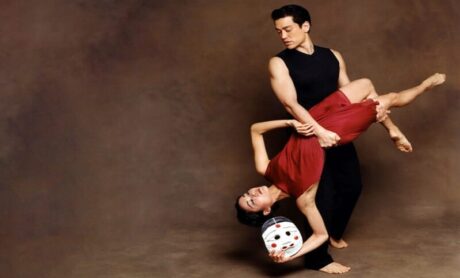
‘Leaving Pusan’ photo by Mary Noble Ours courtesy of Dana Tai Soon Burgess Dance Company.
The concert opened with Leaving Pusan, which is based on Dana’s great-grandmother’s emotional and physical departure from Korea in 1903. In the piece, she travels to Oahu, Hawaii, on the Gaelic — the world’s first steamship that brought Koreans to sugar cane and pineapple plantations — and begins to work on the Del Monte plantation. It tracks her leaving, arrival, and coming to terms with her new home.
There’s a series of “unpacking” — literally and figuratively, as a woman representing Dana’s great-grandmother employs striking mask work with a somu mask, and dress-ography. She struggles to decide amid the pieces of identity symbolizing her homeland, taking pieces on and off. Dancing with her hanbok represents her finding new ground in Hawaii while holding onto her culture. When she dances with a white sheet, a traditional part of a Korean ceremony where one is cut by a dagger then walks through the veil of a spiritual world, she begins the spiritual journey toward trying to let go. There’s something so beautiful and freeing about this prominent solo and the collective movement around it, yet something so stressy.
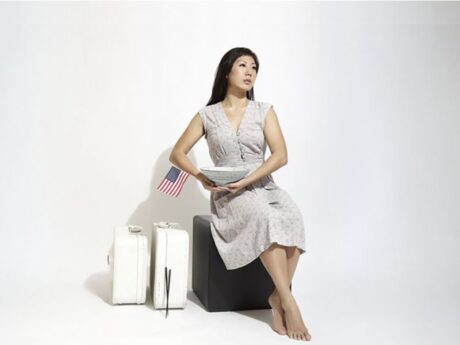
After a brief pause, the concert continues with Becoming American, based on the real-life story of Katia Norri’s journey to understand her new home after being adopted from Korea by an American couple in New Jersey. Norri, a dancer with the company today, contributed what appeared to be her own image, as a little girl’s face is projected, with her adoption number revealed as it zoomed out.
The piece opens with a reveal of a woman “falling” from the sky, between two projections of clouds. At first, she’s scared of falling, then she’s clearly in control; a powerful image. Once she touches the ground, there’s uncertainty. Creepy, faceless people greet her as music gives way to plane noises, a shadowy hooded version of her appears to haunt her, and it’s like she’s a lost child again.
Then, two men greet her with welcoming touches, pirouettes, spins, and outstretched arms. They represent her new parents as they defend her against people trying to take her bags. Just as a welcome is presented, they transition to a moment in an ESL class. As a new family is formed, and her new parents hold her shoulder with such protection, the shadow girl leaves — a piece of her is gone. There’s resignation. There’s assurance and new familiarity but sadness at learning to live in a world that is still yet to be fully known.
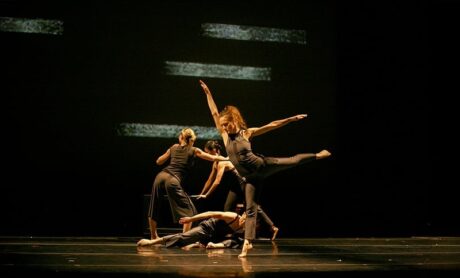
The unknown is explored further in Hyphen, a piece featuring mixed media that includes photos of the company members and experimental films by Nam June Paik. In this piece, the hyphen refers to the hyphenated experience of being Asian American (which I, and the company, stylize without a hyphen; the late great Henry Fuhrmann advocated doing so because the hyphen “serves to divide rather than to connect”). Going further from siloed experiences of one person and representing a wide range of experiences, this piece feels the most abstract.
It begins with the company divided into pairs. Throughout, various small groups are highlighted as each dancer plays with jerky, fluid contractions and expansions of their bodies that present a collective “internal battle” feeling. There is visible trembling. There is reaching. There is kicking. There’s more high-flying action. It rises to the occasion of life-shattering identity-crisis questions like “Does the hyphen divide or separate?” Going from these small groups back to the collective, with one dancer stepping out to hold a camera with a passive gaze as the company’s photos are projected again, this piece — and the concert — ends by leaving the audience to feel that the hyphen brings us together, yet also tears us apart — inside, and from each other.
Free: On Dana Tai Soon Burgess’ philosophy
In a talkback following the concert, Dana revealed his own background with a sport that could be related to dance: martial arts. He “wanted something creative,” but when he discovered dance after martial arts, he was hooked and, for the rest of his life, “didn’t have a choice” as to what he’d be doing. He “sees life through movement.” Gestures, specific geometry, and hyper-detail pull him, as well as emotional conversation.
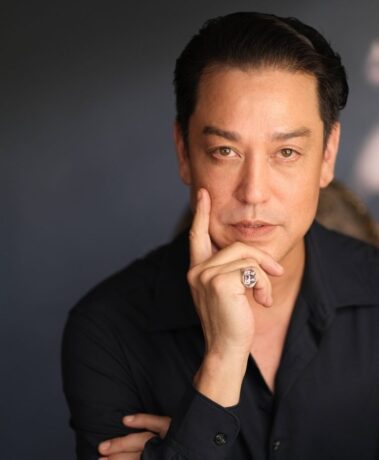
“Our universal language is movement. Every culture moves. We all speak the same language. We’ll all understand the message if individual choreographers find their voice,” Dana said.
He shared that as a choreographer, his focus transitioned from his own personal body to being on the whole space and all dancers as the medium: a more collective perspective. And yet, the way that he finds specifics is so fascinating. He spoke to his movement aesthetic in moments of “question or fear: your body has fight or flight, so all of a sudden you’re ready for flight, then there’s an internal dialogue of consideration of how to keep standing through it all,” he said.
To keep standing amid turmoil is something that was so sorely needed to hear and see. I want to dance more. I want to feel free. I want to be able to open myself up like these dancers can. I want to be expressive. I want to live life without fear. And seeing this work left me inspired and hopeful that maybe I can dance again.
An Asian American Dance Journey played February 27 to March 1, 2025, presented by Dana Tai Soon Burgess Dance Company performing at Woolly Mammoth Theatre Company, 641 D St NW, Washington, DC.
The digital program is viewable here.
CREDITS
Hyphen (2008)
Choreography: Dana Tai Soon Burgess
Dancers: Natasha Ames, Joan Ayap, Tomas Fischer, Trevor Frantz, Felipe Oyarzun Moltedo, William Robinson, Justin Rustle, Aleny Serna, and Baylee Wong
Rehearsal Director: Anne Sidney
Videos: Nam June Paik, Button Happening (1965), Cinema Metaphysique (1967–1972), Hand and Face (1961)
Video Rights: The Nam June Paik Foundation and Electronic Arts Intermix (www.eai.org)
Visual Media Design and Editing: Laura McDonald
Scenic Design: Sara Brown
Music: Ryuichi Sakamoto – Albion Corporation
Music Courtesy of Hefty Records
“Sound in a Dark Room Remix (Ryuichi Sakamoto Remix)” Written by Charles Wesley Cooper III & Joshua L Eustis Performed by Telefon Tel Aviv
Courtesy of Ghostly International
Music Montage: Laura McDonald
Light Design: Felipe Oyarzun Moltedo
Costume Design: Judy Hansen
Becoming American (2011)
Choreography: Dana Tai Soon Burgess
Dancers: Natasha Ames, Joan Ayap, Tomas Fischer, Trevor Frantz, Felipe Oyarzun Moltedo, William Robinson, Aleny Serna, and Baylee Wong
Rehearsal Direction: Anne Sidney
Video Montage: Ricardo Alvarez, Sara Brown
Sound Montage: Dana Tai Soon Burgess, Laura McDonald
어화너 (Eohwaneo) Kim Young Im
Kim Young Im Hwoaesimgog
“Star Spangled Banner” (Piano), Michael Simone USA Vs England – Soccer World Cup 2010
“Suite for Violin and American Gamelan: VII.” Violin Recital: Koh, Jennifer – Higdon, J. – Harrison, L. – Adams, J. – Ruggles, C. (String Poetic)
“Chaconne,” Southwest Chamber Music Composer Portrait Series John Cage, Lou Harrison, and Harry Partch
“String poetic: II. Nocturne” Jennifer Koh & Reiko Uchida
Mrs. Kelleheir ESL Language Teaching “Spectacular /s/” ESL Learning video
Temple Bells Buddhist Drums, Bells and Chants
Light Design: Felipe Oyarzun Moltedo
Costume Design: Judy Hansen
Set Pieces: Charles and Nina Southall
Props: Kelly Moss Southall
Leaving Pusan (2002)
Choreography: Dana Tai Soon Burgess
Dancers: Natasha Ames, Joan Ayap, Trevor Frantz, Felipe Oyarzun Moltedo, Aleny Serna, and Baylee Wong
Rehearsal Director: Anne Sidney
Music: Palmistry by Jason Kao Hwang
Light Design: Felipe Oyarzun Moltedo
Costume and Mask Design: Judy Hansen


